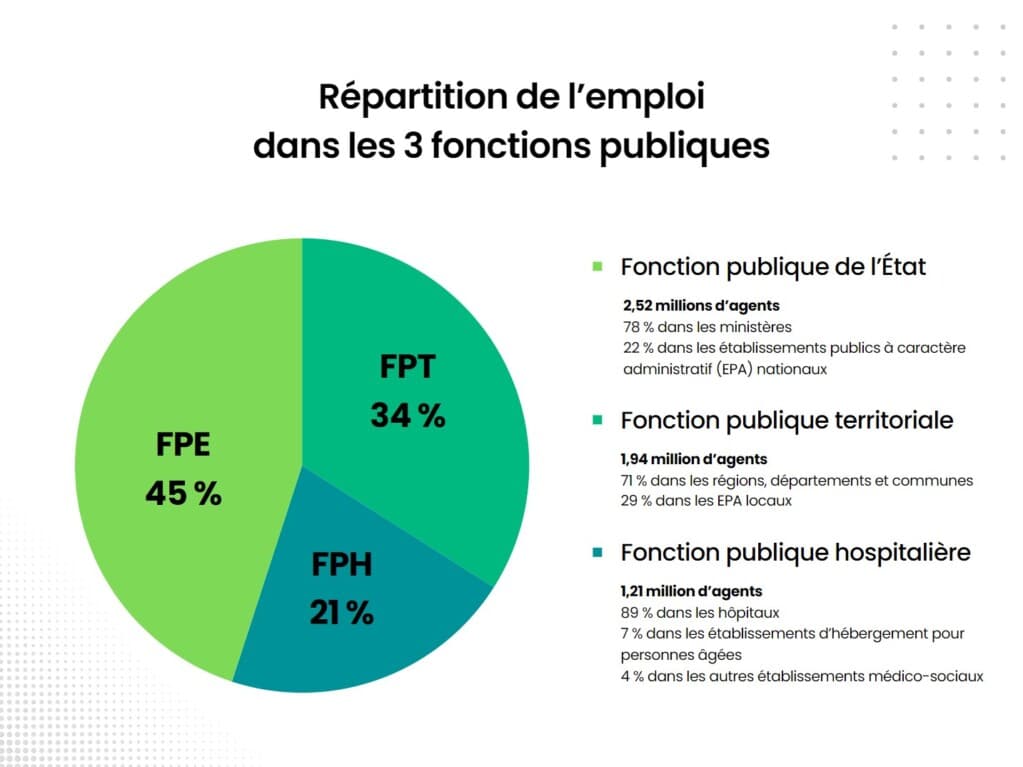[Interview]
The civil service suffers from a lack of attractiveness. In addition to recruitment difficulties, it struggles to build loyalty. “Many managers are leaving,” even underlines Caroline Brethenoux, management trainer for the three public services. For her, restoring the attractiveness of the public sector requires a necessary managerial transformation. But where to start ? What are the expectations of agents and managers? What tools and methods can help revive agent engagement? Here is its lighting.

What are the reasons for this lack of attractiveness of the civil service? Does management contribute to this?
One in two young people have never worked in the public service and are not considering it. Among them, 20 % have a bad image. These are striking figures, relayed by the Human Resources Policy Orientation Council last year. We therefore feel a changing expectations of public officials, particularly younger ones. There may be grievances against management. But the reasons for this disenchantment are varied, like the variety of public service jobs.
Key figures
In France, nearly one in five jobs is a public job.
At the end of 2021, 5.67 million public employees are distributed between:
- the state civil service (FPE)
- the territorial civil service (FPT)
- the public hospital service (FPH)

The public service employs nearly 3.8 million civil servants, around 1.2 million contract workers, some 300,000 military personnel and 360,000 agents falling under “other categories and statuses”.
Among these agents, 38 % fall into hierarchical category A (including 2 % in A+), 20 % of category B and 42 %s of category C.
Source: Key figures 2023, DGAFP.
First, the competition logic allowing access to the status of civil servant and therefore to guaranteed employment for life is no longer successful.
Indeed, many recruitments are made for mission manager or project manager positions. But, these staff no longer take the competitive examinations: they leave at the end of their contract.
Furthermore, there is a sort of perverse effect. To evolve, you often have to accept geographic mobility. Thus, if there is no open position in their community, civil servants do not take the competitive exams to move up in rank. In this case, remaining in the civil service rhymes with downgrading.
Recruitment difficulties or premature departures can also be explained by the arduousness of certain professions. Not to mention the thorny question of low pay, further accentuated by part-time work.
Jobs that no longer make you dream
Firefighter, police officer, nurse… These professions no longer make you dream. We need to restore meaning. This involves in particular the employer brand, but also through local management.
In gendarmerie and firefighting schools, dropout rates are high. Many town halls fear the closure of fire stations: there is a lack of professional firefighters.
As for the hospital civil service, we obviously think of turnover in hospitals. As for the lack of attractiveness, this figure speaks for itself: 30 % of qualified nurses would not work as nurses!
Overall, we must do the same thing with fewer resources. Or even do more, that is to say be more responsive because those administered are more demanding than before. It is in tune with the times…
What are the levers for action to restore attractiveness? What is the role of management?
We'll have to give meaning to the notions of public service and general interest which are strong values. With the employer brand, the public sector can show how everyone contributes and send the strong message: “all professions are important”. But the employer brand can only restore meaning if we rethink HR policy and act on the quality of life at work.
Act in 6 directions:
- Revalorize remuneration
- Improve working conditions
- Strengthen dialogue
- Giving meaning back to work: moving from how to why
- Promote career development
- Turn to more professional training
But the first step is to modernize management methods.
And this, as close as possible to the field. Thus, it is up to category B executives, that is to say local managers, to restore meaning, starting with their own teams. This is an important role and often requires training. Because management in the public sector has particularities.
Exactly, what are the particularities of management in the public sector?
Firstly, there is lifelong employment which has a strong impact on managerial culture in the public service.
Then, slowness. The public sector is less agile.
And above all, the resistance to change is more important than in the private sector. It's a culture shock. Concretely, imagine the gardener who was asked for 20 years to mow the grass short. From now on, he is instructed to leave the grass tall (ecology, biodiversity, etc.). Same scenario in the school canteen with the introduction of a vegetarian menu per week… So, to put it simply: agents need support in the face of transformations in their professions, often linked to transformations in society. This must happen as close as possible to the field with the team manager. But he himself may also need support.
Faced with these particularities, the transformation of management can only go through a continuous improvement process. This is also the impetus given by the State with the “Public Service +” program. This program results from the major consultation carried out in the summer of 2023 with civil service agents. More than 110,253 agents took this opportunity to express themselves (1 in 3 belonged to category B). One of the 6 commitments of this program is to “evolve managerial practices in order to build a relationship of trust, responsibility and restore meaning to the missions of agents. »
On the agent side, what is the main expectation of management?
In the territorial civil service, for example, we are looking for more transversality. With other communities, on the one hand. And also with users, on the other hand.
Overall, agents want work more in project mode. They aspire to teleworking. They also expect a communication effort from managers. In particular, this involves giving visibility to projects carried out by teams, highlighting the successes of a department, or even individual successes. In other words: managers must give marks of recognition and above all make it widely known.
Finally, they are faced with an additional difficulty: the vacant manager positions. For example, in a departmental council, we sometimes have 7 to 9 months of vacancy for A and A+ manager positions. This is very common in public finance positions. People come and go quite quickly. It's not motivating for the teams.
And on the management side, what are the concerns?
One of the main concerns for managers is reporting. How to control the work of employees, when they or themselves are teleworking two to three days a week? How can we prevent teams from feeling “swindled”? Possibly, how to sanction?
Indeed, quantifying and tracing was not part of the public sector culture. Today, we must rationalize. To summarize: what was important before was to do a good job. What is important now is to do it on time, even urgently. It therefore becomes imperative that the manager knows set priorities. In this new context, meetings must also be shorter. We are looking for efficiency. For example: we will favor a record of decisions, a summary document, rather than an exhaustive report of 15 pages.
Second problem: how to support new arrivals? New agents often do not benefit from teleworking for the first 6 months. The manager is present two days a week and the rest of the department is almost empty on Mondays, Wednesdays and Fridays.
Third problem: adopt the manager's posture. If they are sometimes criticized for a lack of managerial courage, they especially lack training. It's not easy to go from colleague to boss.
What are the tools, methods and best practices to transform management?
To move towards a sustainable and operational change in practices, managers must first of all move from a logic of means to a logic of results. To do this, they must:
- implement more efficient management and evaluation tools;
- develop visual management;
- become acculturated to data (data quality, means/results, expectations/impacts).
Then they will gain manage in a more horizontal mode, favoring the project mode. They will also have to adapt their management to hybrid mode. For this, it will be essential to take charge of the collaborative work tools. At this level, Teams is unanimous. As well as Trello for project management. There are no constraints on the choice of tools, but therefore not much harmonization. The proliferation of tools can pose problems for long-time agents. Hence a need for training.
Another avenue is to move towards cooperative management. This involves in particular:
- reviewing the essentials (meeting, conflict management, communication, delegation, etc.)
- a more individualized “micro” relationship
- the use of collective intelligence methods
- exchanges between peers (co-development)
- feedback
- coaching
- the inclusion of all stakeholders (design thinking, Hackaton)
- benevolent management
Finally, the institution itself or the different hierarchical levels must restore legitimacy to local managers. This first means better supporting them, because they sometimes receive contradictory injunctions. This also means better training them to enable them to assert themselves in their position as managers.
Several training priorities for category B executives:
- monitoring and planning tools
- managerial posture and self-affirmation (assertiveness)
- interpersonal communication
- cross-functional communication
How do agents and managers receive the training?
Faced with significant turnover, new agents are no longer trained in the field by their colleagues. This tradition of transmission, essentially oral, has lived on.
Today, tutoring and mentoring could make it possible to rediscover this dynamic of transmission, essential to cohesion. We could even consider using reverse mentoring : new agents train their elders.
The technicalization of professions, especially in the territorial civil service, requires strengthening the training in digital developments. The situation is contrasted between organizations at the forefront, already acculturated to digital, or even AI, and those who have fallen behind. We thus observe a difference between the state civil service and the territorial one. Likewise, a gap has opened up between large metropolises and small towns.
But the good news is that all agents welcome the training offer.
Today, everyone is training: from category C to category A
The ideal is to have a proactive policy with a real management training plan. This is most often the case in large structures which have an extensive HR department, or even a training department.
Outside of this framework, and when the training request is an initiative of the agent, the manager should better frame, or even identify the essential training. Somehow, the manager to define training priorities for the agent, it is up to the agent to choose their training within this scope.
The ideal pace? Training at least once a year.
Furthermore, the agents are waiting for a diversification of training methods.
Especially :
- on-the-job training
- serious games
So, there is no longer any question of spending x days of training, 7 hours a day, sitting behind a table. The agents want to be “actors” during the training. They are also looking for a more playful aspect.
To conclude, I would say that managerial transformation and training efforts should enable the public service to face new challenges: ecology, artificial intelligence, IT security or even attract “digital” profiles beyond the Ministry of defense.





